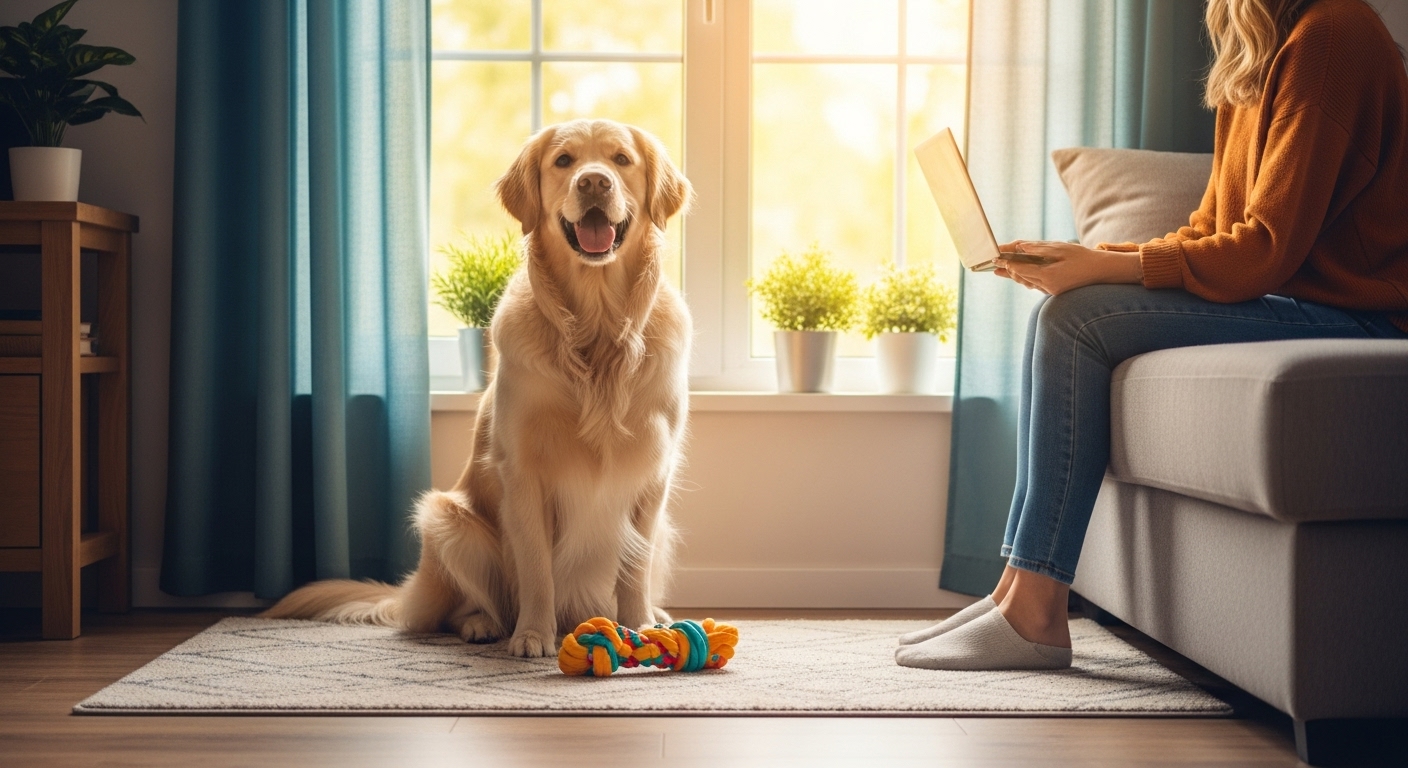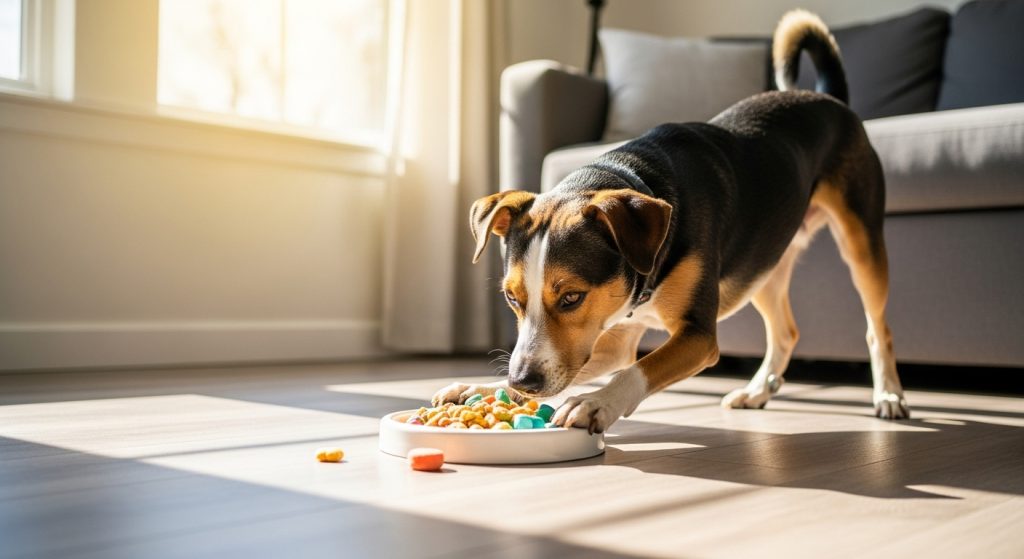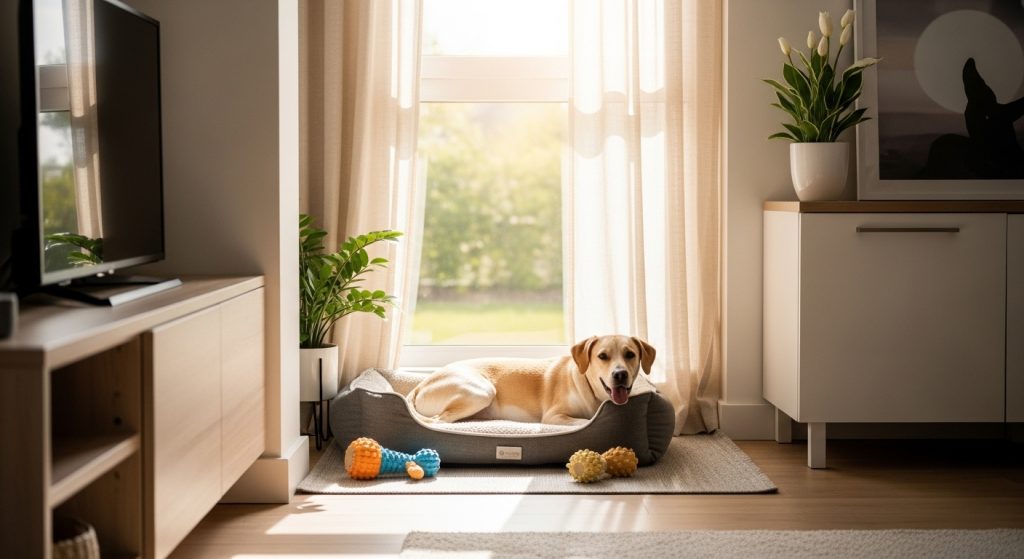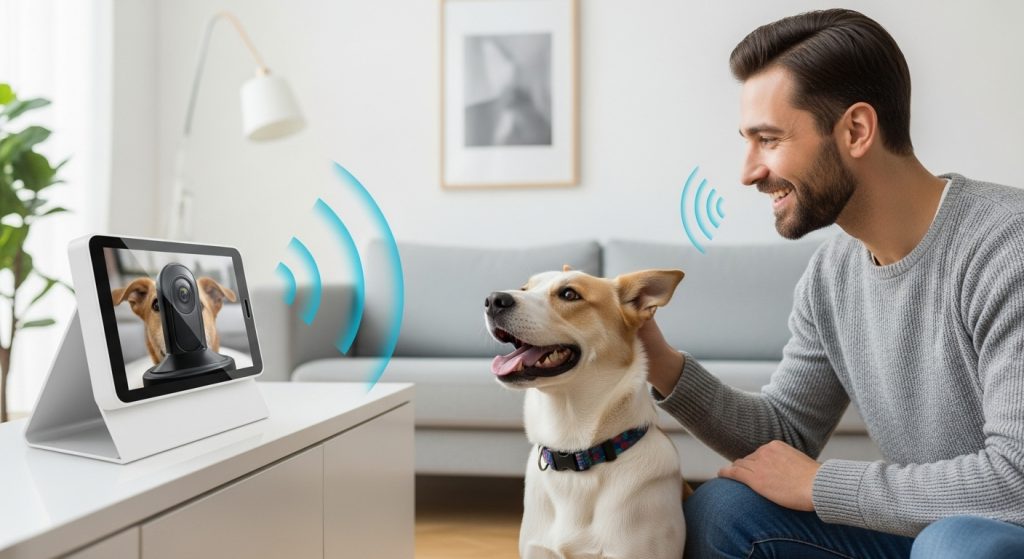If you’ve ever come home to chewed shoes, shredded pillows, or a lonely face pressed against the window, you already know that dogs get bored easily — especially when left alone.
For many pet parents, work and errands make it impossible to stay home all day. The challenge, then, is finding ways to keep your dog entertained when you’re not home, ensuring they stay mentally active, emotionally balanced, and physically engaged.
This guide breaks down three creative strategies:
-
Smart toys and interactive play alternatives
-
Creating a stimulating home environment
-
Incorporating technology and routine to reduce loneliness
Each section ends with a Whisk image prompt you can use to visualize your next blog post design.
Brain Games and Interactive Toys
Keeping your dog’s mind engaged is just as important as exercising their body. A bored mind leads to mischief, but a stimulated one leads to peace and happiness.
I. Puzzle Toys and Treat Dispensers
Dogs love challenges. Toys like the KONG Classic, Nina Ottosson puzzles, or treat-dispensing balls make your dog work for their food — turning mealtime into mental enrichment.
Pro Tip: Freeze peanut butter, kibble, or treats inside a KONG toy. It takes longer for your dog to get the reward, keeping them busy for hours.
Interactive puzzles stimulate problem-solving skills and encourage focus — perfect for intelligent breeds like Border Collies, Poodles, or Australian Shepherds.
II. DIY Homemade Fun
You don’t need to spend a fortune on toys. You can easily create DIY boredom busters using household items:
-
Scent Trails: Hide small treats around the house and let your dog sniff them out.
-
Cardboard Box Game: Fill an empty box with crumpled paper and hide treats inside.
-
Towel Roll Puzzle: Roll treats inside a towel and twist it up — easy and effective!
These activities mimic a dog’s natural foraging instincts, providing hours of mental stimulation.
III. Rotation Keeps It Fresh
Dogs can lose interest in toys if they see them daily. To keep things exciting, rotate their toy selection every few days. Store a few toys away and bring them back later — your pup will think they’re brand new!
Bonus Tip: Assign certain toys for “alone time” only. That way, they associate those toys with positive experiences when you’re gone.
Create a Stimulating Home Environment
Beyond toys, your dog’s surroundings play a huge role in keeping them calm and happy when alone. A thoughtfully arranged environment can make separation time less stressful.
A. Window Views and Visual Entertainment
Dogs are naturally curious. Giving them a spot near a window to watch birds, people, or passing cars keeps them visually engaged.
Tip: Place a bed or perch near the window, but ensure it’s a safe and comfortable space. Avoid open balconies or unprotected ledges.
Some dogs also enjoy dog-safe YouTube videos featuring other dogs, birds, or nature sounds. Background visual and audio stimulation prevents loneliness and keeps the mind occupied.
B. The Power of Scent
Your dog experiences the world primarily through smell. Leaving behind familiar scents can provide comfort when you’re away.
Ideas:
-
Leave an unwashed T-shirt or blanket in their bed.
-
Use dog-safe essential oils like lavender (proven to reduce stress).
-
Create a “sniffing station” using scent mats or hidden treats.
Engaging their strongest sense reduces anxiety and strengthens emotional security.
C. Soothing Soundscapes
Dogs respond positively to calm, rhythmic sounds. Playing soft music or white noise can mask outside sounds that trigger barking or stress.
Try: Classical playlists, “dog relaxation” audio tracks, or CalmPet apps that stream soothing tunes scientifically tested to reduce canine anxiety.
Even leaving the TV on a pet-friendly channel can make your dog feel less isolated.
D. Comfort and Safety Zones
Every dog needs a safe retreat — a cozy bed, crate, or corner where they can relax undisturbed.
Pro Tip:
-
Add a favorite toy and blanket.
-
Keep the area quiet, clean, and temperature-controlled.
-
Reward them for entering it calmly before you leave the house.
Creating a comforting space turns alone time into rest time, not stress time.
Technology, Routines, and Emotional Connection
We live in an age where technology makes it easier than ever to care for pets remotely. Combine that with consistent daily routines, and your dog will feel secure even when you’re away.
i. Interactive Cameras and Treat Dispensers
Smart pet cameras like Furbo, Petcube, or Wyze Cam let you talk to your dog, monitor behavior, and even toss treats remotely.
Why it works:
Hearing your voice can reduce separation anxiety. Rewarding calm behavior remotely reinforces emotional connection.
Plus, you’ll get peace of mind knowing your furry friend is safe and relaxed.
ii. Stick to a Predictable Routine
Dogs thrive on structure. Predictable feeding, walking, and play schedules reduce anxiety by giving your dog a sense of control and expectation.
Example Routine:
-
Morning: Walk + breakfast + short playtime
-
Midday (while you’re gone): Enrichment toys or calming music
-
Evening: Long walk or fetch session + cuddle time
When dogs know you’ll return at roughly the same times each day, they experience less stress.
iii. Hire a Dog Walker or Pet Sitter
If you’re gone for extended periods, a trusted dog walker or sitter can make all the difference. A quick midday walk provides social interaction, exercise, and a bathroom break — all crucial for your dog’s well-being.
Bonus: Some apps (like Rover or Wag) let you monitor your dog’s walks in real time.
iv. Leave Positive Energy Before You Go
Dogs mirror your emotions. If you rush out in a panic, they’ll sense your stress. Instead, leave calmly and confidently. Offer a treat, say goodbye cheerfully, and walk out without hesitation.
Pro Tip: Create a “leaving ritual” — play gentle music, hand them a special toy, and leave quietly. Consistency builds trust.
v. Celebrate Reunions
When you return, don’t immediately overexcite your dog. Greet them warmly but calmly. Over-the-top greetings reinforce anxious waiting. After a few minutes of calm, engage in play or cuddles.
This teaches your dog that being alone isn’t punishment — it’s just part of the daily rhythm.
Happy Dog, Happy Home
Learning how to keep your dog entertained when you’re not home is one of the best gifts you can give your furry friend. From mental puzzles and relaxing soundscapes to smart technology and loving routines, every little effort counts.
Remember: dogs don’t just need food and walks — they need stimulation, reassurance, and connection.
With thoughtful planning, your absence can become a time of calm enrichment rather than anxiety. Your dog stays mentally sharp, emotionally stable, and joyfully awaiting your return.
Because when a dog feels loved, even solitude feels safe.




